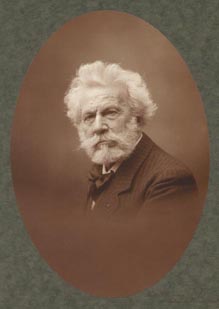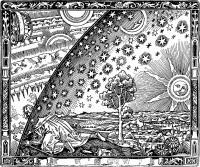Nicolas Camille Flammarion
Nicolas Camille Flammarion (February 26, 1842 - June 3, 1925) was a French astronomer, prolific author of more than fifty titles and member of the Theosophical Society. His writings including popular science works about astronomy, several notable early science fiction novels, and works on psychical research and related topics. He also published the magazine L'Astronomie, starting in 1882. He maintained a private observatory at Juvisy-sur-Orge, France.
Biography
Camille Flammarion was born in Montigny-le-Roi, Haute-Marne, France. He was the brother of Ernest Flammarion (1846–1936), founder of the Groupe Flammarion publishing house. He was a founder and the first president of the Société astronomique de France, which originally had its own independent journal, BSAF (Bulletin de la Société astronomique de France), first published in 1887. His first wife was Sylvie Petiaux-Hugo Flammarion, and his second wife was Gabrielle Renaudot Flammarion, also a noted astronomer. Flammarion died at Juvisy Observatory, Paris, on June 3, 1925.
Theosophical Involvement
Flammarion is mentioned in Mahatma Letter No. 67:
You have among the learned members of your society one Theosophist who without familiarity with our occult doctrine, has yet intuitively grasped from scientific data the idea of a solar pralaya and its manwantara in their beginnings. I mean the celebrated French astronomer Flammarion — "La Resurrection et la Fin des Mondes" (Chapter 4 res.). He speaks like a true seer. The facts are as he surmises with slight modifications.[1]
In the eleventh chapter of Esoteric Buddhism called The Universe, A.P. Sinnett includes Flammarion's ideas about a planet reaching its end of life. This material is similar to what is given in Mahatma Letter No. 67.
The French astronomer Flammarion, in a book called La Résurrection et la Fin des Mondes, has approached a conception of this ultimate materiality. The facts are, I am informed, with slight modifications, much as he surmises. In consequence of what he treats as secular refrigeration, but which more truly is old age and loss of vital power, the solidification and desiccation of the earth at last reaches a point when the whole globe becomes a relaxed conglomerate. Its period of child-bearing has gone by; its progeny are all nurtured; its term of life is finished. Hence its constituent masses cease to obey those laws of cohesion and aggregation which held them together. And becoming like a corpse, which, abandoned to the work of destruction, leaves each molecule composing it free to separate itself from the body, and obey in future the sway of new influences, "the attraction of the moon,” suggests M. Flammarion, "would itself undertake the task of demolition by producing a tidal wave of earth particles instead of an aqueous tide." This last idea must not be regarded as countenanced by occult science except so far as it may serve to illustrate the loss of molecular cohesion in the material of the earth. [2]
The Flammarion Engraving
The "Flammarion engraving" first appeared in Flammarion’s 1888 edition of L’Atmosphère. In 1907, he wrote that he believed that dwellers on Mars had tried to communicate with the Earth in the past.
Online resources
- Camille Flammarion at Wikipedia, the free encyclopedia
- Camille Flammarion at Wikisource
- Camille Flammarion at Theosopedia

